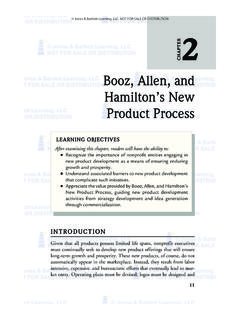Transcription of The Importance and Value of Organizational Goal …
1 The Importance and Value ofOrganizational Goal SettingLearning ObjectivesBy the end of this chapter, you should be able to: Define goal-setting terms: mission, objectives, goals , strategy, and action plans. Define the Value and power of goal settingfor organizations and for managers. Describe how to use a mission statement fordetermining potential goal areas to developand plan for your Principles Into PracticeBy the end of this chapter, you should produce: Your organization's mission statement. This is a good springboard to developing yourdepartment or work unit's mission statement. Your department's mission statement. This will serve as a working document thatassists you in brainstorming potential goals with your staff and "If you don't know where you are going, any road will get you there.
2 " Thisline from Alice in Wonderland has been true in many organizations and com-panies. They often don't have-or maybe don't articulate very well-realbusiness goals other than "staying in business." Most businesses have fiscalgoals, of course, but that may be simply a financial variation of staying inbusiness. Besides wanting to survive, do most organizations know where theyare going? Because of stiffer competition, new technologies, more complexregulations, and increasing global opportunities, organizations today are see-ing the Value of setting a clearer direction from top to bottom and putting alltheir energies and resources into moving toward that destination. Setting thisdirection through goal setting often leads to greater market share, higherprofits, new products and services, and more committed employees.
3 Goalsetting also becomes a tool to measure progress and to help define futuredirection. Though it is true that setting and accomplishing organizationalgoals won't guarantee success for any organization, not having and accom-plishing Organizational goals brings certainty of long-term setting is one of the most prominent and basic tools used by bothindividuals and organizations to assist in setting their direction and in accom-plishing it. Successful companies and other organizations (public sector andnonprofit entities) often set both long- and short-term goals , not only forsales, products, and service development but also for improving quality,reducing errors, becoming more customer-focused, and building betterinternal and public 's where you come in. You're likely a manager in an organizationthat has set some business objectives at the executive level, and you've beentold to make it happen in your part of the organization.
4 For some, this maymean not so much setting the goals as redefining them for your departmentand then developing the action plans to reach those goals . Others may beasked to set their own departmental goals but to make sure that they actuallyfurther the organization's broader course is designed to be a practical, hands-on guide to both settingand redefining goals for your department and giving you the "nuts and bolts"of planning and guiding the process of achieving those goals process includes aligning resources, developing goal strategies, getting"buy-in" from the members of your department, delegating responsibilitiesand task assignments appropriately, and outlining what to do when some-thing goes wrong on your journey to accomplishing your department's chapter has both specific learning objectives and practical objec-tives to be completed.
5 Both a conceptual understanding component ( ,understanding how to communicate the goals to your staff and a practicaloutcome ( , developing from a worksheet a speech that you can deliver tosell the goals at a staff meeting). Unlike courses that are mostly conceptual,this course is designed to be a resource to which you can refer over and overwhen you are setting, planning, and carrying out SOME GOAL-SETTING TERMSThe terms we need to define in this segment of this chapter are shown inExhibit 1-1. They are mission, objectives, strategy, goal, and action plans. In laterchapters we'll get into how to use these concepts; right now, we need just todefine and understand organization's mission is the reason behind its establishment, what it ismeant to do or to produce. In short, why it exists. In the business sector, itis the products or services that it produces and provides.)
6 In the public sec-tor and nonprofit entities where there is a lesser emphasis on products, it iswhat the organization is trying to accomplish. Most nonprofit groups areestablished either to start something ( , a local industry council might beestablished to attract business to the community) or to stop something ( ,the March of Dimes is trying to stop or at least prevent birth defects).Knowing your organization's mission seems like a given, but it is importantto goal setting because each goal that you develop for your departmentmust in some tangible way move the larger organization toward accom-plishing its stated organizations have an official mission written out in a missionstatement. Reviewing this document can be helpful to you with departmen-tal goal setting. You can even invite those in your department to gettogether and write your department's mission statement based on that ofthe larger organization.
7 It is a good activity to precede formal goal settingbecause it helps people get into the proper mind-set for determining thegoals that they might need to set to help contribute to accomplishing theorganization's mission. In fact, either writing a new departmental missionstatement or reviewing one that exists in your organization is one of thepractical objectives for this final aspect of an organization's mission (and therefore oftenincluded in its mission statement) is a brief summary of its values and par-ticularly how those values shape how the mission will be carried out. Thisshould be not simply a formality. Organizations that experience long-termsuccess know who they are. They hold themselves to a Value system thathelps define that instance, a local company with long-held community ties mayinclude in their mission statement: "We strive to be a good neighbor and apositive contributor to the well-being of this community.
8 " A potentiallymeaningful Value is embedded in that sentence. We say potentially because thereal test is in whether or not an organization lives up to its espoused values intangible ways. For instance, say the company had a chance to expand itsoperation and double its factory size. This could lead to an even longerrecord of success. It is a good business decision. However, in order to live upto the Value stated earlier, the company would need to conduct a communityimpact study to determine how the expansion would affect their the company would need to use the results of that study to help shapehow the expansion took place. Perhaps the community would request thatthe company's new facility be located in another part of the same communitybecause to expand the existing plant would make the area too congested.
9 Thecompany would need to take into account as much as possible the needs ofthe community when planning and building the expansion if its values werereally taken final note: Living up to your values (organizationally and individu-ally) has tremendous business Value . It enhances your reputation in the busi-ness community, it builds long-term business relationships with customersand suppliers, and it makes it a lot easier to sleep at night!ObjectivesObjectives are statements of broad intent that often arise out of the missionstatement. A company's mission statement might, for example, include thefollowing statement: "We will lead our industry through exemplary customerservice." An objective of the company, then, would be always to emphasizeexemplary customer service in all its dealings with customers. There wouldnot be a time when the company would consider that area completely ful-filled and replace it with another idea.
10 Therefore, an objective is contrast, goals are not; they have a beginning and an end. goals will bediscussed further in just a the previous example, the company should set goals related to theoverall objective of exemplary customer service. For instance, "One goal is tocut in half (50 percent) our response time to satisfying customer complaintsin the next six months." The company will know when or if it has accom-plished the goal. When it does, it needs to set new goals still based on theobjective-in this case, exemplary customer service. The objectives (mostoften three or four) drawn from the mission statement become the bridgebetween the often intangible mission and the very tangible goals an organiza-tion must have to get its work done in the most productive be that your organization doesn't have a formal mission statementfrom which you can extract its primary objectives.











